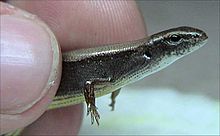Scincella lateralis
| Scincella lateralis | |
|---|---|
 |
|
| Scientific classification | |
| Kingdom: | Animalia |
| Phylum: | Chordata |
| Subphylum: | Vertebrata |
| Class: | Reptilia |
| Order: | Squamata |
| Suborder: | Sauria |
| Infraorder: | Scincomorpha |
| Family: | Scincidae |
| Genus: | Scincella |
| Species: | S. lateralis |
| Binomial name | |
|
Scincella lateralis (Say, 1823) |
|
 |
|
| Synonyms | |
|
|
Scincella lateralis is a small species of skink found throughout much of the eastern half of the United States, and into northern Mexico.
Common names for this species include the little brown skink and the ground skink. However, the common name, ground skink, may refer to any species in the genus Scincella.
The little brown skink is one of the smallest reptiles in North America, with a total length (including tail) of only 3 - 5.5 inches (7.5 - 14.5 cm). Its back is typically a coppery brown color with a white or yellow underside, and like most skinks has an elongated body and short legs. Transparent disks in the lower eyelids allow it to see with its eyes closed (Beane 2006, Palmer et al. 1995).
The ground skink is found throughout much of the Eastern United States, from New Jersey, Ohio [1], and Kansas south to Texas and Florida, as well as into northern Mexico. It is absent from higher elevations in the Appalachian Mountains.
S. lateralis lives in a variety of habitats, including deciduous or mixed deciduous/coniferous forests, hedgerows, and the edges of streams and ponds. It does require a deep substrate, such as leaf litter.
The ground skink is a fossorial species, spending the majority of its time buried in leaf litter on the forest floor. Unlike other skinks, it seldom climbs trees. Its usual means of locomotion is to wriggle through the leaf litter with undulating movements. It may dive under water when pursued, although normally avoids wet areas. It is largely diurnal, but may be active at night as well. It hibernates during the coldest months, but may be active in almost any month of the year in North Carolina (Palmer et al. 1995). As befits a tiny lizard, the home range of an individual may be as small as 20 square meters (Natureserve).
...
Wikipedia
